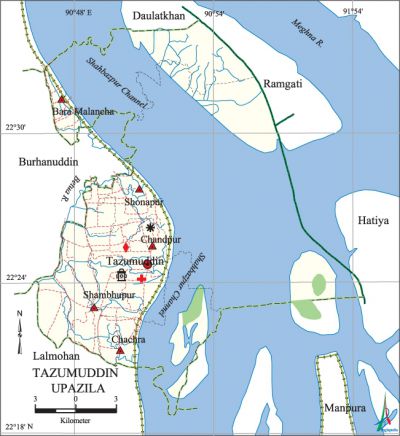Tazumuddin Upazila
Tazumuddin Upazila (bhola district) area of 512.91 sq km, located in between 22°21' and 22°34' north latitudes and in between 90°47' and 91°01' east longitudes. It is bounded by daulatkhan upazila on the north, lalmohan, manpura upazilas and meghna river on the south, hatiya and ramgati upazilas and Meghna river on the east, burhanuddin upazila on the west.
Population Total 126940; male 65139, female 61801; Muslim 118934, Hindu 8000, Buddhist 1, Christian 4 and others 1.
Water bodies Main rivers: Shabajpur Channel, Meghna, Betua. Shabajpur Channel covers the half of total area of the upazila.
Administration Tazumuddin Thana was formed on 28 August 1928 and it was turned into an upazila on 14 March 1983.
| Upazila | ||||||||
| Municipality | Union | Mouza | Village | Population | Density (per sq km) | Literacy rate (%) | ||
| Urban | Rural | Urban | Rural | |||||
| - | 5 | 36 | 75 | 20941 | 105999 | 247 | 44.2 | 42.7 |
| Upazila Town | |||||
|
Area (sq km) |
Mouza |
Population |
Density (per sq km) |
Literacy rate (%) | |
| 20.39 | 3 | 20941 | 1027 | 44.2 | |
| Union | ||||
| Name of union and GO code | Area (acre) | Population | Literacy rate (%) | |
| Male | Female | |||
| Chanchra 38 | 11088 | 6376 | 6077 | 35.4 |
| Chandpur 57 | 9167 | 22055 | 20752 | 41.8 |
| Bara Malancha 19 | 10715 | 4045 | 3798 | 37.7 |
| Shambhupur 85 | 8868 | 17441 | 17339 | 44.6 |
| Sonapur 76 | 20079 | 15222 | 13835 | 47.3 |
Source Bangladesh Population Census 2011,Bangladesh Bureau of Statistics.

War of Liberation In 1971 the Pak army conducted mass killing, plundering and set many houses on fire. 7 freedom fighters were killed in the upazila in different encounters with the Pak army.
For details: see তজুমদ্দিন উপজেলা, বাংলাদেশ মুক্তিযুদ্ধ জ্ঞানকোষ (Encyclopedia of Bangladesh War of Liberation), বাংলাদেশ এশিয়াটিক সোসাইটি, ঢাকা ২০২০, খণ্ড ৪।
Religious institutions Mosque 156, temple 30, tomb 4, math 5.
Literacy rate and educational institutions Average literacy 42.9%; male 44.6%, female 41.1%. Educational institutions: college 1, secondary school 7, primary school 104, kindergarten 2, madrasa 77. Noted educational institutions: Tazumuddin Degree College (1989), Chandpur Government High School (1952), Fazilatunnessa Girls' High School (1972), Shambhupur High School, Chandpur Model Government Primary School (1943), Debipur Madrasa (1910).
Cultural organisations Library 1, club 10, cinema hall 2, playground 7, orphanage 1, cyclone shelter centre 1, co-operative society 301, women's organisation 62.
Main sources of income Agriculture 74.15%, non-agricultural labourer 3.97%, industry 0.21%, commerce 9.06%, transport and communication 1.66%, service 4.03%, construction 0.57%, religious service 0.36%, rent and remittance 0.22% and others 5.77%.
Ownership of agricultural land Landowner 58.43%, landless 41.57%; agricultural landowner: urban 58.83% and rural 58.36%.
Main crops Paddy, wheat, potato, pulse, mustard, sugarcane, ground nut.
Extinct or nearly extinct crops Local varieties of paddy, vegetables.
Main fruits Mango, jackfruit, litchi, banana, papaya, olive, coconut, shaddock, betel nut.
Fisheries, dairies and poultries Fishery 7, dairy 21, poultry 41.
Communication facilities Roads: pucca 76.91 km, semi-pucca 9.03 km, mud road 158.97 km; waterway 41 km.
Extinct or nearly extinct traditional transport Palanquin, bullock cart.
Noted manufactories Flour mill, rice mill, saw mill, ice factory.
Cottage industries Jute work, bamboo work.
Hats, bazars and fairs Shashiganj Hat, Khasher Hat (North), Khasher Hat (South), Yasinganj Hat, Choto Daury Hat, Bhuban Thakur Mela and' Shambhupur Mela are notable.
Main exports Ground nut, coconut, betel nut, potato.
Access to electricity All unions of the upazila are under rural electrification net-work. However 14.0% of the dwelling households have access to electricity.
Sources of drinking water Tube-well 96.7%, tap 0.2% and others 3.1%.
Sanitation 71.8% of dwelling households of the upazila use sanitary latrines and 25.2% of dwelling households use non-sanitary latrines; 3.0% of households do not have latrine facilities.
Health centres Hospital 1, upazila health centre 1, union health and family planning centre 2, veterinary hospital 1.
Natural disasters About twenty two thousand people were victims of the cyclone and tidal bore of 1970; they also caused heavy damages to properties of the upazila. Besides, the flood of 29 April 1991 caused loss of life and heavy damages to properties of this region.
NGO activities Operationally important NGOs are brac, asa. [Bidhu Bhushan Roy]
References Bangladesh Population Census 2001 and 2011, Bangladesh Bureau of Statistics; Cultural survey report of Tazumuddin Upazila 2007.
